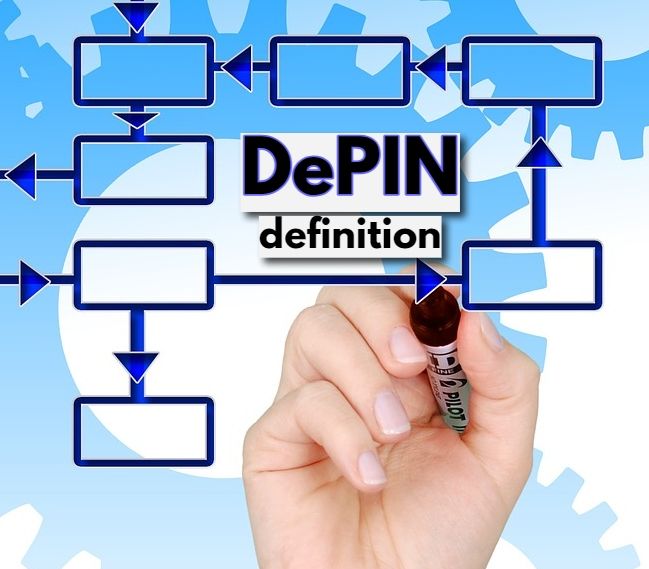
DePIN – definition. What does this acronym stand for? Definition and concrete examples.
DePIN – definition of this acronym.
If you follow decentralized finance news, then you’ll often come across this acronym. Here’s a complete definition and some concrete examples..
DePIN – definition
DePIN, or Decentralized Physical Infrastructure Networks, refers to a model where physical infrastructure and services are managed, owned, and governed through decentralized networks, typically using blockchain technology.
This concept leverages decentralized finance (DeFi) principles to facilitate community ownership, distributed governance, and incentive alignment for the development and maintenance of physical infrastructure. Examples include decentralized networks for energy distribution, telecommunications, transportation, and other utilities.
Key characteristics of DePIN include:
1.Decentralization
Description: In a DePIN model, infrastructure is managed by a decentralized network rather than a central authority.
Development: Decentralization in the context of DePIN means that the control and decision-making processes are distributed across a wide array of participants rather than being concentrated in a single entity. This distribution is typically achieved through the use of blockchain technology, which allows for a distributed ledger that is accessible and verifiable by all participants in the network. Decentralization enhances resilience as there is no single point of failure, and it also promotes innovation by allowing multiple stakeholders to contribute and propose improvements. For instance, in the Helium Network, individual users set up and maintain hotspots, providing network coverage collectively rather than relying on a centralized telecommunications company.
2. Community Ownership
Description: Stakeholders in the network, often through token ownership, have a say in governance and decision-making processes.
Development: Community ownership is a cornerstone of DePIN, enabling a more democratic and participatory approach to infrastructure management. By owning tokens, participants can vote on important issues such as protocol upgrades, fee structures, and the allocation of resources. This ensures that those who are most invested in the success of the network have a voice in its governance. For example, in the Energy Web project, stakeholders can vote on governance proposals that affect how the energy grid is managed and optimized. This community-driven approach ensures that decisions are made in the best interest of the network as a whole, rather than a central authority.
3. Incentive Mechanisms
Description: Participants are rewarded for contributing to the network, such as by providing services, maintaining infrastructure, or participating in governance.
Development: Incentive mechanisms in DePIN are designed to align the interests of individual participants with the health and growth of the network. Participants earn rewards, usually in the form of network tokens, for their contributions. These contributions can include providing essential services, such as storage space in the case of Filecoin, or network coverage in the case of Helium. Additionally, maintaining infrastructure and active participation in governance (e.g., voting on proposals) are also rewarded. These incentives not only motivate individuals to join and actively participate in the network but also ensure that the network remains robust and well-maintained over time.
4. Transparency and Security
Description: Utilizing blockchain technology ensures transparency in transactions and operations, enhancing security and trust among participants.
Development: Transparency and security are critical to the trust and functionality of DePIN. Blockchain technology provides a transparent ledger of all transactions and operations, which can be independently verified by any participant. This transparency helps prevent fraud and ensures that all actions within the network are visible and accountable. Security is also enhanced through cryptographic techniques inherent in blockchain, protecting data and ensuring the integrity of the network. For example, in Filecoin, every transaction related to storing and retrieving data is recorded on the blockchain, ensuring that all activities are transparent and can be audited. This transparency fosters trust among participants, as they can be confident that the network operates fairly and securely.
These characteristics collectively enable DePIN projects to create decentralized, community-driven, and resilient infrastructures, transforming traditional models of infrastructure management.
By decentralizing physical infrastructure, DePIN aims to create more resilient, efficient, and equitable systems compared to traditional centralized models.
Exemples
Here are some concrete examples of DePIN (Decentralized Physical Infrastructure Networks) projects:
- Helium Network: Helium is a decentralized wireless network for IoT (Internet of Things) devices. Participants set up Helium hotspots to provide network coverage and are rewarded with HNT tokens for their contribution. The network uses blockchain technology to track transactions and rewards.
- Filecoin: Filecoin is a decentralized storage network where users can rent storage space from other participants. Storage providers are rewarded with FIL tokens for their contributions. Blockchain technology ensures the security and transparency of storage and retrieval transactions.
- Energy Web: Energy Web is a decentralized platform for energy management. It uses blockchain technology to enable more efficient and transparent management of electrical grids, facilitating the integration of renewable energy sources and energy storage solutions. Participants can be rewarded for producing and consuming green energy.
- Nodle Network: Nodle is a decentralized IoT connectivity network that allows mobile devices to become nodes in an IoT sensor network. Users are rewarded with NODL tokens for participating in the network by providing connectivity to IoT devices.
- Pollen Mobile: Pollen is a decentralized mobile network where participants can set up base stations to provide cellular coverage. They are rewarded with Pollen tokens for the bandwidth and coverage they offer. The network uses blockchain to ensure transaction transparency and security.
These projects demonstrate how DePIN can transform the management and ownership of physical infrastructure by leveraging decentralized technologies and token-based incentives.
DePIN – definition, the summary
DePIN, or Decentralized Physical Infrastructure Networks, is a model where physical infrastructure and associated services are managed, owned and governed by decentralized networks, often using blockchain technology. This concept relies on decentralization, community ownership, incentive mechanisms and transparency to create resilient, efficient and equitable systems. In short, DePIN transforms traditional infrastructure management by enabling decentralized governance (DAO), community participation and token-based incentives.
